Shrewsbury Abbey, located in Shropshire, England, has been around for a Long Time! Founded as a Benedictine Monastery in the latter part of the 11th century, the portion of the Abbey that is still standing serves as a parish church.
For those who aren’t local to the area, but who are fans of British mystery shows, Shrewsbury Abbey (technically, the Abbey Church of St. Peter and St. Paul) is well known as the setting for the Cadfael mystery series.
When Virginia, a reader of Needle ‘n Thread, visited the Abbey recently, she took pictures of some of the embroidery she saw at the Abbey and sent the photos along. I thought I’d share them with you today. They’re beautiful!
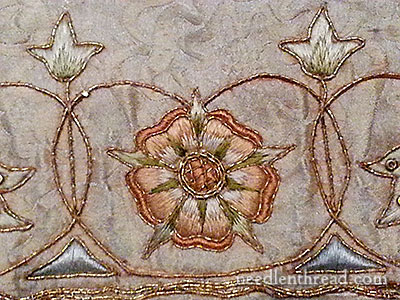
I’m not sure what the different embroidered items are – I’m guessing from the shapes I can make out and the structure of the designs that we’re looking at some kind of frontal. Notice the Tudor-type rose, which is often found in English church embroidery.
I like the color scheme here – the paler pastels are very pretty. I’m not sure the age of the pieces, or whether or not there’s some fading going on, but I would imagine not much – the gold looks to be in pretty good shape, the grey is quite deep, so I’m guessing these colors are not far off from the original color scheme. I like the coral on the rose.
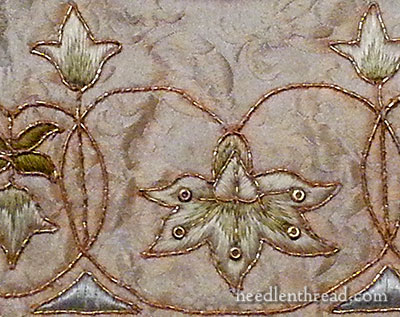
Here’s what looks like a continuation of the same piece – same background fabric, same basic layout, same grey triangles. Notice the gold bits on the lily, that look a little bit like spangles. I like these things! They aren’t flat spangles – they’re more donut-shaped.
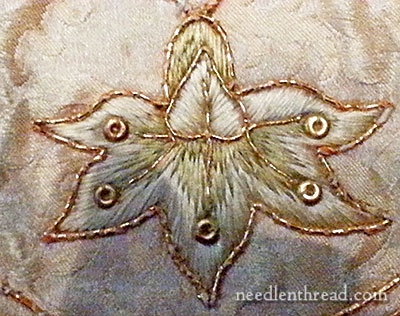
You can see the gold accents a little better here. You don’t see this shape too often – I’ve only ever seen it on ecclesiastical embroidery from England. I’m not sure if they were used more widely or not.
I like them! I’d use them in goldwork if they were still available today! They’d make nice foundations or settings for pearls and the like.
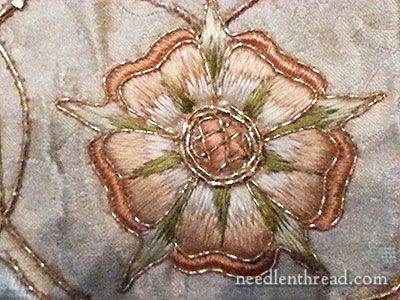
Here’s a rose close up. Love the lattice in the middle!
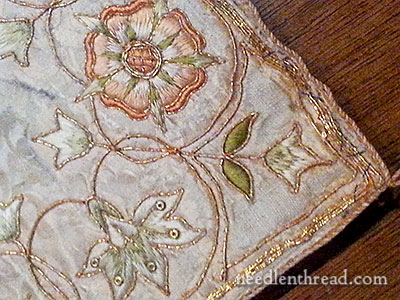
And here’s a corner of the piece, where you can see the lily motif and the rose motif meet. The gold is quite damaged right along the corner. It looks like there’s a nice cord or twist along the edge.
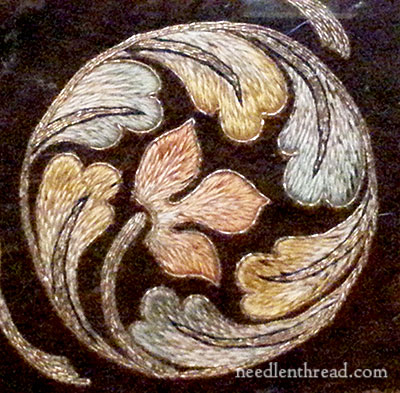
I love this! Such a simple design element, but the movement and shading in it are quite nice! And the colors are very effective on the dark background. I especially like the goldwork “veins” in the center of each “leaf” area, and the fact that they are further outlined with black. It’s very striking!
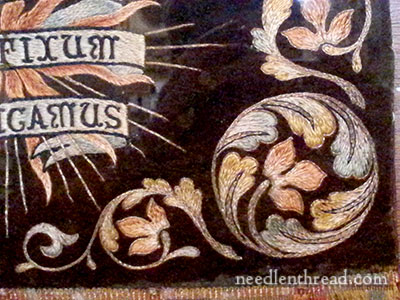
Here, you can see that design element in context on the corner of something that I’m assuming is either a frontal, a pulpit fall, or even a banner of some sort. There’s some fringe along the bottom of whatever it is.
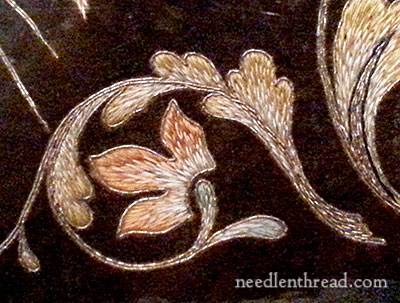
And another bit of design detail from the same piece. I like the goldwork on the lower right, as it moves up the swash and melds into the silk shading. So pretty!
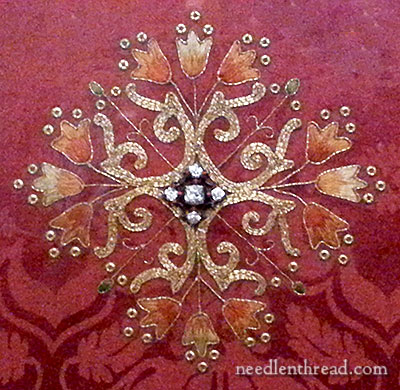
Another striking piece – gold on a red background always catches they eye! This piece sports some gems in the center of the cross and a nice array of gold spangles be-speckling the outer perimeter of the whole design.
I like the way the flowers are not in high contrast to the background. They’re very subtle, but still there. And the couched goldwork is exquisitely done – very uniform and neat.
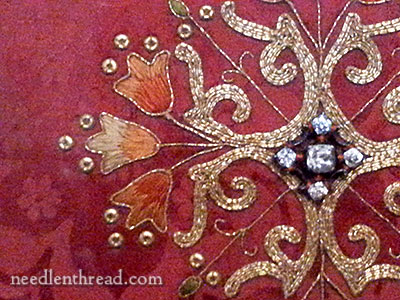
And here you can see the flowers a little closer. Notice that the “shading” on the flowers is rather rigid. It’s not a natural shading, with a smooth transition between colors. But if you step back from the piece, it doesn’t matter – the effect of the shading is pleasing from farther away.
Thanks, Virginia, for sending along the photos! I always appreciate the opportunity to travel vicariously, and I hope you all enjoyed a look at these bits of beautiful embroidery from Shrewsbury Abbey.







I’m really sorry, Mrs. Corbet, but I didn’t get the pictures sent to you yesterday. I’ll try to get them sent today, I promise.
In the meantime, I do very much agree that those pieces of embroidery are VERY beautiful.
I just can’t believe it’s almost Christmas, though! just six days away now! Ahhhhhhhhhhhh! 😮
I was in Shrewsbury a few weeks ago. We staying in a hotel just along the road from the Cathedral. I didn’t really have time for sight seeing but if I had seen these pictures before I went, I would have tried hard to make time to visit the Cathedral. Maybe next time!
The gold bits look like spangles before they are squished or only lightly squished. I like them! I too would use them if they were available today. Thank you, Mary and Virginia for sharing these pictures.
Thank you so much for sharing this. I love history, and when it’s combined with needlework I’m just ecstatic!! When I was younger, much younger, I never appreciated either one. Should I ever win the lottery… well, I plan to travel to many of the places I read about to see the wonderful embroideries and techniques. In the meantime, your website keeps feeding my thirst for this knowledge!
Dear Mary
Cadfael is one of favourite programmes in fact it’s being re-run at the moment and I am glued to it, I didn’t know Shrewsbury Abbey was the setting of Cadfael how interesting, I hadn’t heard of the Abbey and it’s embroidery. The pictures of the embroidered pieces above are lovely I especially like the Cross on the gold and red background with the gems in the centre. Thanks virginia for the pictures and thanks Mary for sharing them with us.
Regards Anita Simmance
I ought to point out that the series was not filmed in Shrewsbury. The writer of the books, Edith Pargetter, writing as ‘Ellis Peters’ did make sure the books were historically accurate. There is a memorial window to Edith in the Abbey Church.
My friend and I were there in 2005..or was it 2006…I should look up my photos as well. What I remember is that the interior is quite a bit darker than expected- this might explain why the pieces don’t appear to be as faded. I have any number of embroidery photos from that trip should you be interested in seeing them-if so, let me know- proably the best were from a chapel in Guilford- quite a modern church as it so happens, but there were 2 pieces done by an embroiderer who worked for William Morris. They were a tribute to her brother who was killed in WW I. The res of the church had some amazing frontals as well.
The tiny circles of goldwork are interesting. Since I have never seen them in goldwork supplies, I am wondering if one could use tiny O rings like at the end of a bracelet or necklace where the hook closes the circle? Something to think about. I wonder what some of your readers who are more versed in goldwork embroidery think. Anyhow, nice history post!
Exquisite! Thanks to both of you for sharing these photos. 🙂
The “fat spangles” remind me of modern metal eyelets, with the “doughnut” shape and rounded edges. I’m guessing eyelets don’t come in genuine gold, but they might be fun to experiment with to get a similar look.
Mary, I have a question about your comment regarding the corner motif on the dark brown banner: “I especially like the goldwork ‘veins’ in the center of each ‘leaf’ area, and the fact that they are further outlined with black. It’s very striking!” I noticed that, too! I’m especially impressed by how subtle the black looks; it’s there, but it’s not so bold that it overwhelms the paler golds. This is something I’m struggling with in a blackwork project. No matter what type of black thread I use, it always seems to have too much contrast and overwhelm the accompanying gold threads. Do you have any suggestions for achieving that subtle combination?
Thank you so much!
~Elizabeth
Beautiful pieces! The EGA seminar is taking place near me next fall and I plan to take a 3 day goldwork class. I am so looking forward to it!
How strange to see embroidery from Shrewsbury – where I live – in Needle’n’Thread! I look out at the Abbey Church from my kitchen window. A happy Christmas to you, Mary, from Shrewsbury.
We love visiting the old churches and Cathedrals whilst on our travels too . This embroidery is lovely , not sure how old it is..it looks so bright and fresh .
Thank you for embroidery from the Abbey. It was the perfect non-fattening “pick me up” after a very looong work day. Elegant and etherial.PAM
Well Mary, I’ve always been perplexed when looking at the Tudor Rose in embroidery: I just couldn’t work out the “star” shape which appears to be imposed on the rose. I still am unsure about the Tudor Rose but this morning the petals fell off into my hand from a late spring rose and there it was, the star shape in a green petal shape behind the rose hip. Such a sweet “hidden” treasure!!
G’day Mary,
And thank you to Virginia for these photos of preciousness. I particularly love the dark fabric corner motifs. There is such a fluid movement to the circle motif one can easily imagine it rotating. The side motifs are little flowing worlds of delight in themselves. Guardians of the main motif.
Thanks for all your interesting discussion points on each piece. I found it all fascinating.
Cheers, Kath.
Oh wow. How absolutely beautiful. I love the softer colours in this and the fabric looks quite delicious as well. It is interesting to see how methods of work are changing, eg, the thread shading on the flowers in the last photograph. What fortune some people have, to see this stuff up close and personal. But then to think of their less fortunate fellow embroiderers and send photos, that is truly great. Thank you, to both of you, Virginia and Mary.
Hi Mary,
I’m a day late commenting but I thought I’d offer-up a few observations. First, thank you for sharing the photos, I enjoy seeing ‘historical’ era needlework! The patterns and designs are very similar to the illustrations in illuminated manuscripts. Someone interested in embroidering a similar piece could do a little research via the Bodelian Library or a Google search. (Sounds like another project . . .) Anyway, I enjoyed this post and would love to see similar whenever you have photos like these to share.
I love that rose! Such an elegant pattern and the colours are so pretty.
Unfortunately, much of the 12hC work is faded. The dyes were not colour-fast as in today. If you could see the backs or unpick you would see the beautiful colour ranges. We tend to think of the UK churches as being dull when in reality they were bright and extremely colourful. I think there is some confusion between the Abbey and the Cathedral in some of the comments. Must go back next year and have a look.